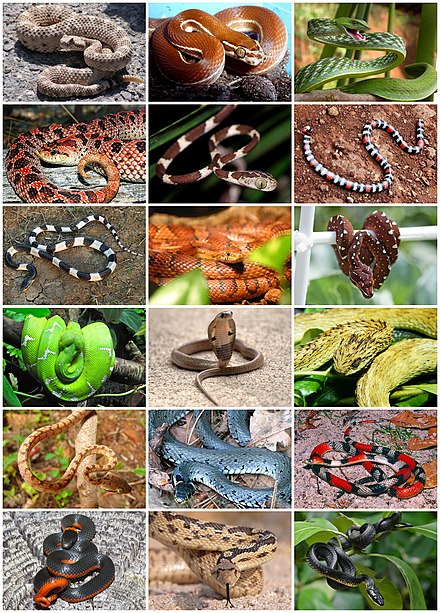Snakes are members of the reptile suborder Serpentes and are found in most areas of the world except the polar regions and some islands. Snakes, which come in various subfamilies and species, lost their limbs during evolution, elongated their bodies, and specialized into a unique appearance without obvious external ears and eyelids.

Body size: The body length of snakes ranges from small snakes of a few centimeters (such as blind snakes in the order Snakes) to extreme individuals such as pythons and anacondas that can exceed 10 meters.
Skull: The skulls of most snakes are very flexible and the lower jaw halves are not firmly connected, allowing them to swallow prey much larger than their own heads.
Skin: A snake's skin is covered in scales that help the snake move across the ground and sheds its skin periodically as they grow.
Movement methods: Snakes move in various ways, including crawling, side sliding, short bow curves and "straight lines".
Hunting Behavior: Different species of snakes have different hunting strategies, some ambush hunters while others actively chase their prey.
Diet: Most snakes are carnivorous, and their prey include mammals, birds, insects and other reptiles. Some snakes will also eat bird eggs or insects.
Hunting and venom: Some snakes are venomous, such as rattlesnakes, cobras, and various vipers, and use their venom for hunting or defense. Some snakes, such as pythons and king snakes, kill their prey by strangling them.
Reproductive methods: Snakes reproduce in various ways. Most snakes are oviparous, meaning they lay eggs. But there are also some snakes, such as vipers, that are viviparous and give birth to their young inside the mother's body.
Breeding season: The breeding season is usually during the warm season to ensure that the young snakes can grow before the cold season arrives.
Diverse Habitats: Snakes can adapt to everything from tropical rainforests, deserts, grasslands, forests, bodies of water, and even some areas in the ocean.
Cold environment: In cooler environments, snakes hibernate.
Environmental threats: Habitat reduction, environmental pollution, disease and hunting by humans are the main threats facing snakes.
Conservation status: Many snakes are now listed as protected species, particularly those threatened by the pet trade.
Cultural significance: In different cultures, snakes symbolize wisdom, demons, healing and revival with complex meanings.
Agricultural Role: Snakes play an important role in agriculture as they help control pests and rodents.
Venom Research: Snake venoms become an important source of biological research, including use in drug development.
In summary, snakes are an important component of diversity and functional diversity in ecosystems, and their protection is crucial to the balance of the natural environment.
animal tags:
We created this article in conjunction with AI technology, then made sure it was fact-checked and edited by a Animals Top editor.